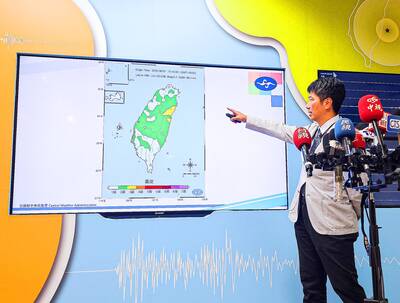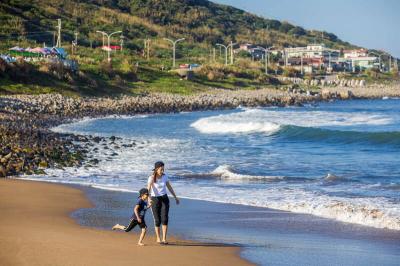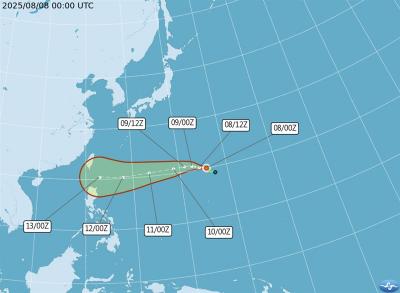Leading an idyllic life in the countryside after retirement may be a dream come true for some, but it did not turn out so well for a 74-year-old woman who recently suffered a penetrating head injury caused by a cornstalk.
Chang Ming-yuan (張明元), an attending physician at Cathay General Hospital’s neurosurgery department, said the woman, surnamed Chen (陳), has a vegetable farm in Taipei’s Nangang District (南港) next to a deserted cornfield filled with dried cornstalks.
“In August last year, Chen went out to inspect the cornfield at dawn. She slipped and fell. When she stood up, she realized that a cornstalk had pierced her right cheek and tried to pull out the object by herself,” Chang said.
Chen managed to remove the visible part of the stalk before falling unconscious. She was rushed to the hospital by her family.
Unsure of what had happened, the hospital conducted a computerized tomography (CT) scan of the woman’s head. After the CT scans failed to provide a clear picture of what was inside the woman’s head, it decided to carry out a craniotomy.
“We found that the cornstalk had entered Chen’s skull from her right cheekbone and penetrated her cranial base, causing a 3cm-wide facial injury and a skull base fracture,” Chang said.
About a month after the removal of the 8cm-long object, Chen suffered a brain abscess and had to undergo two more craniotomies to drain it.
She subsequently received a titanium implant for skull defect reconstruction, Chang said.
“Most penetrating head injuries are caused by hard and blunt objects, such as a wooden stick or iron bar. It is the first time we have ever seen a cornstalk piercing a person’s skull,” Chang said.
He said Chen was extremely lucky, because she could have suffered speech impairment had the object penetrated her left temporal lobe.
She also would not have survived the accident if she had managed to remove the stalk by herself, Chang said, adding that it was quite fortunate that she managed to pull through after a brain abscess, as the condition has an 80 percent mortality rate.

Aftershocks from a magnitude 6.2 earthquake that struck off Yilan County at 3:45pm yesterday could reach a magnitude of 5 to 5.5, the Central Weather Administration (CWA) said. Seismological Center technical officer Chiu Chun-ta (邱俊達) told a news conference that the epicenter of the temblor was more than 100km from Taiwan. Although predicted to measure between magnitude 5 and 5.5, the aftershocks would reach an intensity of 1 on Taiwan’s 7-tier scale, which gauges the actual effect of an earthquake, he said. The earthquake lasted longer in Taipei because the city is in a basin, he said. The quake’s epicenter was about 128.9km east-southeast

GENSLER SURVEY: ‘Economic infrastructure is not enough. A city needs to inspire pride, offer moments of joy and foster a sense of belonging,’ the company said Taipei was named the city with the “highest staying power” in the world by US-based design and architecture firm Gensler. The Taiwanese capital earned the top spot among 65 cities across six continents with 64 percent of Taipei respondents in a survey of 33,000 people saying they wanted to stay in the city. Rounding out the top five were Vietnam’s Ho Chi Minh City (61 percent), Singapore (59 percent), Sydney (58 percent) and Berlin (51 percent). Sixth to 10th place went to Monterrey, Mexico; Munich, Germany; Sao Paulo, Brazil; Vancouver; and Seoul. Cities in the US were ranked separately, with Minneapolis first at

The New Taipei City Government today warned about the often-overlooked dangers of playing in water, and recommended safe swimming destinations to cool off from the summer heat. The following locations in the city as safe and fun for those looking to enjoy the water: Chienshuiwan (淺水灣), Baishawan (白沙灣), Jhongjiao Bay (中角灣), Fulong Beach Resort (福隆海水浴場) and Sansia District’s (三峽) Dabao River (大豹溪), New Taipei City Tourism and Travel Department Director-General Yang Tsung-min (楊宗珉) said. Outdoor bodies of water have variables outside of human control, such as changing currents, differing elevations and environmental hazards, all of which can lead to accidents, Yang said. Sudden

Tropical Storm Podul has formed over waters north-northeast of Guam and is expected to approach the seas southeast of Taiwan next week, the Central Weather Administration (CWA) said today. The 11th Pacific storm of the year developed at 2am over waters about 2,660km east of Oluanpi (歐鑾鼻), Pingtung County — Taiwan's southernmost tip. It is projected to move westward and could have its most significant impact on Taiwan on Wednesday and Thursday next week, the CWA said. The agency did not rule out the possibility of issuing a sea warning at that time. According to the CWA's latest update, Podul is drifting west-northwest